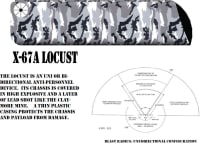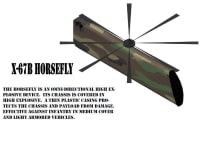The TUCAV (Tactical Unmanned Combat Aerial Vehicle) is a small rotary wing infantry support weapon system (the body is two feet long by five inches thick) designed to support the U.S. military against asymmetrical and traditional forces. The TUCAV allows close range surveillance, keeps soldiers out of fire, instills fear into the enemy, and adds a third dimension to combat while being inexpensive and easy to use. Using Commercial Off The Shelf and Government of the shelf components the TUCAV is an inexpensive force multiplier. Most Unmanned Combat Aerial Vehicles are long range strategic weapons requiring expensive guidance and control systems. The TUCAV is designed to be a short range weapon guided by laptop and a camera mounted in its nose, or even a simple controller and eyeball. The hit and run nature of modern warfare, especially in urban environments, is casualty intensive for our troops. The TUCAV is designed to ensure American soldiers always have the high ground, forcing the enemy to engage targets above and in front of them rather than to their front alone while also instilling fear into the enemy.
The TUCAV’s drive train would mainly be manufactured from existing radio controlled rotary aircraft designs and mounted to a lightweight frame carrying the communications and control system. Body panels would be shipped unassembled for loading of antipersonnel, high explosive, and incendiary charges and their detonators. The TUCAVs can be controlled individually or in “flocks” which allow one operator to control several machines in numerous formations. Hot swap of direct control would allow a flock to loiter out of small arms range as the operator chooses specific weapons systems to engage specific targets. The sound of the flocks can be tailored for silent operation at night, or tailored to make a loud buzzing noise to intimidate the enemy and help break their will. Since they are extremely thin they are hard to engage with rifles until close enough to create casualties even when damaged. When damaged they will self-destruct if beyond their minimum arming range.
The X-67A Locust is an Antipersonnel TUCAV loaded with a bilaterally arced central high explosive charge lined with ball bearings. It is in essence a two sided claymore mine designed to eliminate infantry. This would have been especially useful in the second battle of Fallujah where US forces trapped an enemy force against a river. Trapped forces with no escape tend to fight harder and longer inflicting more casualties. Multiple flocks deployed down the narrow downtown streets could have lessened resistance saving American lives. The X-67B Horsefly is a high explosive variant of the TUCAV designed to engage infantry in medium cover and light armored vehicles. The X-67C Hornet is an incendiary designed for engaging infantry, light armored vehicles, and buildings. Comprised of an incendiary fluid, bursting charge, and ignition charge it creates a cloud of flammable liquid which it then ignites. A simpler white phosphor round could also be used.
Like this entry?
-
About the Entrant
- Name:Travis Wernecke
- Type of entry:individual
- Software used for this entry:PROE WILDFIRE FIVE/CREO
- Patent status:none








